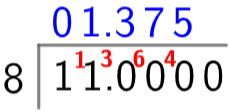This page contains the GCSE AQA Mathematics Converting between Fractions Decimals & percentage Questions and their answers for revision and understanding Converting between Fractions Decimals & percentage.
Here we will be going through how to convert between fractions, decimals, and percentages (in all directions).
Decimals and Percentages
Converting between decimals and percentages is nice and straightforward.
• Convert decimal to percentage – multiply by 100 (shift decimal point right two places).
• Convert percentage to decimal – divide by 100 (shift decimal point left two places).
Example: a) Write 37% as a decimal.
b) Write 0.548 as a percentage.
a) To convert this to a decimal we will divide by 100, so we get
37÷100=0.37
b) To convert this to a percentage we will times by 100, so we get
0.548×100=54.8%
Decimals and Fractions
Converting between decimals and fractions is a little more work.
• Convert fraction to decimal – treat the fraction like a division and divide the number on the top by the number on the bottom. There are ways we can make this process easier, which we’ll see in the examples below.
• Convert decimal to fraction – write the decimal as a fraction with 1 on the bottom. Then, keep multiplying top and bottom by 10 until the decimal becomes a whole number.
Example: a) Write 12/25 as a decimal.
b) Write 11/8 as a decimal.
a) Dividing 12 by 25 doesn’t sound too pleasant, but there is a way we can change the fraction (before dividing top by bottom) to make life easier. Notice that 25×4=100 and dividing by 100 is straightforward. So, if we times top and bottom by 4 we get
12/25 =48/100=0.48
So, we have successfully converted this fraction to a decimal.

b) In this case, there is no nice shortcut. We’ll just have to divide 11 by 8 in whichever way feels most comfortable – here, we’ll go for the bus stop method (make sure to put lots of zeroes after your decimal point!) Doing this, we get the picture shown on the right, and we see that the result is
11/8=1.375
Example: Write 4.56 as a fraction in its simplest form.
Any number divided by 1 is equal to itself, so we can write 4.56 as 4.56/1. Now, if we multiply top and bottom by 100 (or multiply by 10 twice, if you’re not sure why we choose 100), and we’ll see that we get
4.56/1=4.56×100/1×100=456/100
Success! We’ve written the decimal as a fraction. All that remains now is to simplify it. Cancelling out factors (until there are no common factors left), we get
456/100=228/20=114/25
Fractions and Percentages
We’ll use the tools we’ve already learned to help us convert between fractions and percentages.
• Convert percentages to fractions – a percentage is already out of 100, so we must put the value in a fraction over 100. Then, if necessary, multiply top and bottom by powers of 10 to make the values into whole numbers.
• Convert fractions to percentages – firstly convert the fraction to a decimal (using the method we’ve seen), then convert that decimal to a percentage (also using the method we’ve seen).
Example: Write 48.1% as a fraction.
As mentioned, percentages are already out of 100 so
48.1%=48.1/100
Then, multiplying top and bottom by 10 (to make the numbers whole) we get
48%=481/1000
Example: Write 4 /5 as a percentage.
Firstly, let’s convert it to a decimal. Notice that if we times top and bottom by 2, the fraction becomes
4/5=4×2/5×2=8/10
Now, dividing by 10 isn’t too tricky: 8÷10=0.8. Then, to convert this decimal to a percentage, we times by 100:
0.8×100=80%
NOTE: Alternatively, if you can write a fraction with 100 on the denominator, then the value on the top immediately gives you what the fraction would be as a percentage. For example,
34/50=68/100=68%
